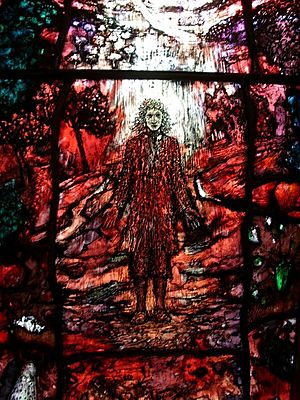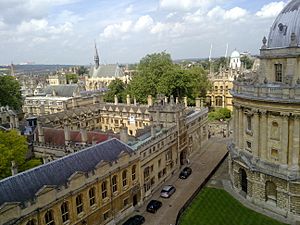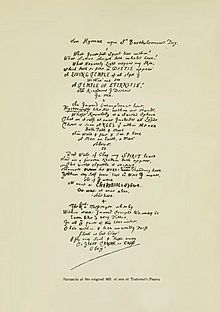Thomas Traherne facts for kids
Quick facts for kids
Thomas Traherne
|
|
|---|---|

One of the four Traherne Windows in Audley Chapel, Hereford Cathedral, created by stained-glass artist Tom Denny
|
|
| Born | c. 1636–38 Hereford, England
|
| Died | 27 September 1674 Teddington, Middlesex, England
|
| Alma mater | Brasenose College, Oxford |
| Occupation | Poet, author, priest, theologian |
|
Notable work
|
Centuries of Meditations |
| Style | metaphysical poetry, meditations, theology |
Thomas Traherne was an English poet, writer, and priest who lived a long time ago, from about 1636 to 1674. He is known for his special way of writing about God, nature, and how amazing childhood can be. Many people in the Anglican Church remember him on October 10th or September 27th each year.
His most famous book is called Centuries of Meditations. It's a collection of short thoughts where he shares his ideas about life, happiness, and the wonder of being a child. This book was found and published long after he died, in 1908. His poems were also published later, in the early 1900s.
Traherne often wrote about how beautiful the world is and how close he felt to God. His writing shows a strong, almost childlike love for God. People compare his ideas to those of later poets like William Blake and Walt Whitman. He loved nature so much that his writings sound like the "Romantic" poets, even though he lived two centuries before them.
Contents
Thomas Traherne's Life Story
Early Years and Schooling
We don't have records of when Thomas Traherne was born or baptized. A historian named Anthony à Wood said he was born in Hereford, England, around 1636 or 1637. He was thought to be the son of a shoemaker. However, other sources suggest his father was Philipp Traherne, a local innkeeper and mayor of Hereford.
Traherne wrote about his childhood in his book Centuries of Meditations. He described how he felt a natural sense of wonder and appreciation for the world around him.

Thomas went to Hereford Cathedral School. Then, he started at Brasenose College at the University of Oxford in 1652. He earned his first degree in 1656. Later, he received his Master of Arts degree in 1661 and a Bachelor of Divinity degree in 1669.
His Work as a Priest
After finishing his first degree at Oxford in 1656, Traherne decided to become a priest.
In 1657, he became the rector (a type of priest) of Credenhill, a village near Hereford. He worked there for ten years. Even though he wasn't officially ordained as a priest yet, he was given this important role.
After King Charles II returned to the throne, Traherne was officially ordained as a priest in 1660.
In 1667, Traherne became the private chaplain for Sir Orlando Bridgeman, 1st Baronet, of Great Lever. Sir Orlando was a very important official for King Charles II. Traherne lived with him in Teddington, near Hampton Court Palace. Thomas Traherne died there on September 27, 1674. He was buried in St Mary's Church in Teddington.
His Personality and Simple Life
People who knew Traherne described him as a very kind and clever person. They said he had a "cheerful and lively" personality. He was always ready to help his friends and was very generous to those in need, even if he didn't have much himself.
Traherne himself felt he was "Too much openness and proneness to Speak." This means he thought he talked too much and was too eager to please others. He lived a simple and religious life. His will showed that he owned very little, mostly just his books.
Thomas Traherne's Writings
How His Works Were Published
Thomas Traherne was not famous as a writer during his lifetime. Most of his works were not known or appreciated until long after he died. He was a quiet country priest and didn't spend time with other writers. Only one of his books, Roman Forgeries, was published while he was alive in 1673.
Two other books, Christian Ethicks (1675) and A Serious and Patheticall Contemplation of the Mercies of God (1699), were published soon after his death. The last one was published without his name, by an unknown author.
When Traherne died in 1674, most of his handwritten papers went to his brother, Philip. After Philip died, these papers seemed to disappear for almost 200 years.
Later Discoveries and Publications
In the late 1800s, some old, anonymous handwritten papers were found in London. At first, people thought they might be by another poet named Henry Vaughan.
However, a bookseller named Bertram Dobell carefully studied them. He realized they were not by Vaughan but by Thomas Traherne! These papers included poems and a collection of deep thoughts about religion and life.
Because of this discovery, The Poetical Works of Thomas Traherne was published in 1903. Then, his most famous work, Centuries of Meditations, was published in 1908. People later called the Centuries "one of the finest prose-poems in our language." Parts of his writings have even been turned into music.
Important Handwritten Copies
Several of Traherne's original handwritten books are kept in famous libraries. For example, a copy of Centuries is at the Bodleian Library in Oxford. Another, called "Poems of Felicity," is at the British Library in London.
In 1996, a long, unfinished poem by Traherne called "The Ceremonial Law" was found in the Folger Shakespeare Library in Washington, DC. In 1997, even more of his writings were discovered at the Library of Lambeth Palace in London. These included four complete works and a part of a fifth, mostly prose.
Ideas and Beliefs in His Works
Neoplatonism's Influence
Traherne was greatly influenced by Neoplatonist thinkers. These philosophers believed that there was a higher, perfect reality beyond what we can see and touch. He was also influenced by a group called the Cambridge Platonists.
The Cambridge Platonists believed that religion and reason could work together. They thought that reason was a special gift from God, like a "candle of the Lord," that helped people understand divine things.
One critic noted that Traherne wrote about our senses as if they were spiritual. He wrote about the spirit as if it could experience things through the senses.
Understanding Sin
Traherne spent a lot of time thinking about sin and its place in church teachings. In one of his recently found works, A Sober View of Dr Twisse, he talked about sin and how people can be saved.
He wrote that people are kept out of Heaven if they hate God. But nothing that loves God can be kept out. He believed that losing God's love is like being in Hell, and seeing and having God's love is like being in Heaven.
Mystical Ideas and Connecting with God
Traherne's writings are often called "mystical." This means they try to understand and feel the nature of God within the world and inside a person's soul. In Centuries of Meditation, Traherne seems to describe his own spiritual journey. This work is known for its "spiritual intensity" and how it covers "all heaven and earth."
His work is said to look "upon the hidden things of the soul." In these hidden parts, he saw "the image of the glory and love of God." He also saw "the eternal theme of the goodness and the splendour of God."
Traherne's poems often explore how wonderful creation is and how close he felt to God. He used ideas from ancient Greek thinkers like Aristotle and early Christian leaders to understand humans and their nature.
Some critics have said his poems might sound like pantheism. This is the idea that God is everything, or that God is in everything.
The Idea of "Felicity"
A main idea in Traherne's work is "felicity." This means the highest state of happiness or bliss. He described God as a source of "Delights of inestimable value."
Traherne believed that true happiness comes from understanding God's will and divine love. He described this beauty in simple, childlike ways. He tried to explain that humans naturally want to love truth and beauty. He saw felicity as the source of this desire and a natural experience.
Other Important Ideas
Love for Nature
Another strong feeling in Traherne's work is his deep love for nature and the natural world. He often wrote about nature in a way that sounds like the Romantic movement, which came much later. He believed that God created nature, and he praised its beauty. Some scholars think he was trying to help people appreciate the natural world again.
He often wrote about how humans and nature are connected. He also tried to describe sensory experiences exactly as they happened, a technique later used by poets like William Wordsworth.
Childlike Joy and Wonder
Traherne's main idea is the "visionary innocence of childhood." His writings suggest that adults have lost the joy they had as children. With that loss, they also lost an understanding of how divine and wonderful creation is.
Traherne seemed to believe that we can only find paradise again by getting back this childlike innocence. This state is full of endless love and wonder.
Because of this, Traherne's work is often compared to the joyful and mystical writings of William Blake, Walt Whitman, and Gerard Manley Hopkins. A scholar named Denise Inge noted that Traherne was one of the first writers to use a child's viewpoint to explain his religious and moral ideas.
Finding Happiness
Achieving happiness is another main focus in Traherne's work. He wrote, "I will first spend a great deal of time in seeking Happiness, and then a great deal more in enjoying it." He believed that many people don't value happiness enough. He also wrote that in Heaven, everyone will see our happiness, and we will enjoy being happy without showing off.
Practical Philosophy
Traherne wanted people to use the insights they gained from philosophy in their daily lives. He believed that deep thoughts should help us live better.
His Lasting Impact
Most of Traherne's works were not published until the early 1900s. Since then, many important people have been influenced by him. These include the monk Thomas Merton, the writer Dorothy L. Sayers, and the author C. S. Lewis. Lewis called Centuries of Meditations "almost the most beautiful book in English."

The Anglican Church also recognizes Thomas Traherne. While they don't make saints in the same way as the Roman Catholic Church, they often honor people who lived very holy lives. Because of his poems and spiritual writings, Thomas Traherne is remembered in the Calendar of Saints in many Anglican churches around the world. The Church of England remembers him with a special day.
Traherne is remembered on either September 27th (the day he died) or October 10th (the day he was buried). In 2009, the Episcopal Church in the United States approved a special prayer to use on his feast day.
- Observed on 27 September
- Episcopal Church in the States
- Observed on 10 October
- Church of England; Anglican Church of Korea; Hong Kong Sheng Kung Hui (also known as the Hong Kong Anglican Church)
Music Inspired by Traherne
People have noticed that Traherne loved music very much. The Traherne Association has a list of about 100 composers who have used his words in their music. These composers come from many different countries and have created music in various styles, from classical songs to modern pieces.
British Composers
The first known musical setting of Traherne's words was in 1917 by Bryceson Treharne. It was a song for a singer and piano. In 1924, Rutland Boughton created a song for men's voices using Traherne's words. Later, composers like Elizabeth Maconchy set both his poems and prose to music.
Gerald Finzi started working on his important piece, Dies natalis, in the 1920s. It's a cantata for a high solo voice and string orchestra. It was finished in 1939 and first performed in 1940. This work uses prose from Traherne's Centuries of Meditations and three of his poems: "The Rapture," "Wonder," and "The Salutation." The words chosen show the joy and wonder of a newborn child seeing the beautiful world for the first time.
Many modern musical settings of Traherne's work are religious. His poem "The Rapture" was included in a hymn book in 1967 with music by William Wordsworth. Other composers like Patrick Larley, Colin Matthews, and Cecilia McDowall have also written music for special occasions using Traherne's words.
International Composers
Composers from other countries have also been inspired by Traherne. Toivo Tulev from Estonia set lines from Centuries of Meditations to music for a performance honoring the queen in 2006. Dobrinka Tabakova from Bulgaria, Claude Ballif from France, and Jouni Kaipainen from Finland have also created works based on Traherne's writings.
In North America, Canadian composer Frederick Karam wrote an anthem called "From Dust I Rise" in 1958, using lines from Traherne's poem "The Salutation." In the United States, Aaron Jay Kernis and Bob Chilcott have also set Traherne's words to music.
Music Without Words
Some composers have created instrumental music inspired by Traherne. Japanese composer Satoru Ikeda created two works based on "The Salutation," one for voices and instruments, and another purely instrumental. Australian composer Nigel Butterley wrote Meditations of Thomas Traherne for orchestra.
Two organ pieces have been inspired by the Traherne windows in Hereford Cathedral. American Peter Stoltzfus Berton based his "Hereford Variations" on Centuries of Meditations. Martin Bussey also created an organ work called "Hereford Windows."
Traherne's writing has also been used in larger musical works. Kenneth Leighton's Symphony No.2 included lines from Traherne's "Thanksgivings for the Body." Harrison Birtwistle's opera The Last Supper also featured a quote from "Thanksgivings for the Body."
Even outside of classical music, the Incredible String Band used lines from Centuries of Meditations in their song "Douglas Traherne Harding" in 1968. This shows how widely Traherne's work can be used and appreciated.
Images for kids
-
St Mary's, Credenhill, Herefordshire, where Traherne was rector
See also
 In Spanish: Thomas Traherne para niños
In Spanish: Thomas Traherne para niños



